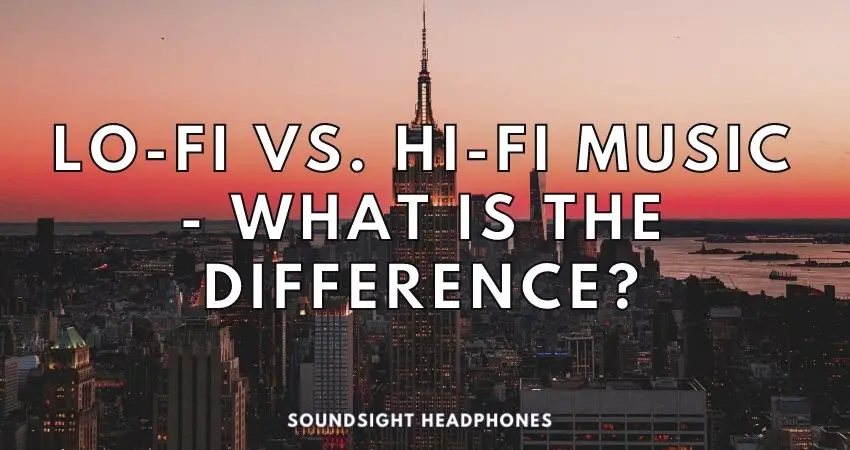Lo-Fi and Hi-Fi are two different audio qualities. One is characterized by its lo-fi (low fidelity) sound, which has become popular in recent years, and the other by its hi-fi sound – the preferred audio standard by music connoisseurs worldwide. The difference between low-fidelity and high-fidelity music is evident and easy to understand, based on the amount of audio data bits, but hi-fi and lo-fi are still frequently confused and misunderstood by less informed people.
Because of the frequent confusion, the need for clarity becomes apparent. In this article, we’ll discuss the following:
- Define Lo-Fi and Hi-Fi audio terms
- Explain the difference between Lo-Fi & Hi-Fi music by highlighting their main aspects
- Provide examples of Hi-Fi and Lo-Fi music
- Answer frequently asked questions about Hi-Fi and Lo-Fi music
Understanding sound fidelity
To explain the difference between Lo-Fi and Hi-Fi, we must first establish what sound fidelity is.
The consensus is this: sound fidelity entails how accurate, complete, transparent, and faithful the recording or playback of a given recording is.
The fidelity of the sound relies on the quality of the recording and the playback ability of the audio gear. As such, you can have a pair of high-fidelity headphones that play back a poor-quality recording or a lowly iPod that plays back the highest-fidelity recording. Neither will offer a satisfactory experience.
However, since we are talking about music fidelity, i.e., Lo-Fi and Hi-Fi music, the device used to play the sound is the only variable.
So we won’t focus on the playback ability of the audio device. Instead, we’ll focus on how these music styles compare (high-fidelity vs. low-fidelity) and whether they are meant to be played back at home or on a portable player, and what makes them special.
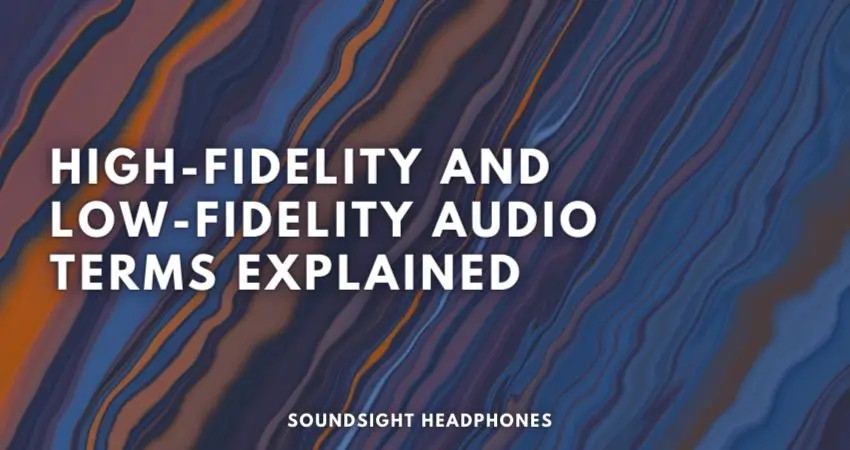
What are High-fidelity and Low-fidelity – A quick summary
Before getting into the differences between Lo-Fi and Hi-Fi music, an overview of High-fidelity and Low-fidelity music helps you understand the meaning of these terms. In fact, Hi-Fi or High fidelity is considered to be the highest quality reproduction of sound.
- High-fidelity embodies the highest possible precision in sound reproduction. The phrase “High fidelity” was first used as a marketing term in the mid-1950s to describe better audio quality than average. The term “High fidelity” also refers to a state of perfection in recording quality and the fidelity of the music reproduced by the equipment.
- In contrast, low-fidelity is characterized by average, least accurate sound reproduction or minimally detailed sound. It’s synonymous with low-definition, a state of low quality that fails to accurately represent the original signal and features a low sampling rate and bitrate.
When music is recorded “live,” with multiple microphones or tracks, the resulting recording is similar in sound quality to a live musical performance. On the other hand, the quality of music reproduction depends on the quality of the device that plays back the recorded music.
A more in-depth explanation of Lo-Fi Music
A thorough description of what Lo-Fi music is:
Lo-fi music is generally one step removed from the final recording. The music is deliberately recorded with low-quality equipment, at a lower sampling rate, poorly mastered with a small degree of noise, or simply incompletely produced. The result is a small audio file with monotonous or repetitive rhythms, instrumentation, and ordinary sound quality reproducing tangible artifacts, distortion, and noise.
Simply put, Lo-fi music is recorded in a way to emphasize poor sound quality or in a plain fashion. There are many views on how lo-fi music can be produced, from simple to sophisticated. And the fact is that people tend to achieve different goals when it comes to lo-fi music.
Generally, low-fidelity music isn’t designed for active and attentive listening but rather for background or ambient listening, i.e., listening to music while doing something else – studying, learning, working, etc. that doesn’t require the utmost attention to detail. It’s a musical genre of which elements include the following:
- Distortion, noise, and the use of unconventional mixing techniques.
- Lack of refinement, producing music that is simplistic in structure and composition.
- Deliberate use of imperfections, misplayed notes, or incomplete range of music notes.
- Simpler and more direct rhythm than normal music.
- The use of one or a few instruments rather than a full orchestration or a complex soundstage.
Thus far, Lo-Fi music is often produced with an amateur veneer in mind, but it isn’t to be confused with music that is recorded in a low-quality manner. You can have both: Lo-Fi music as inadvertently and improperly recorded music and Lo-Fi music as a musical style. It’s not surprising to see thousands of Lo-Fi playlists on YouTube and many sub-genres of lo-fi music, as the genre has taken off in the last decade.
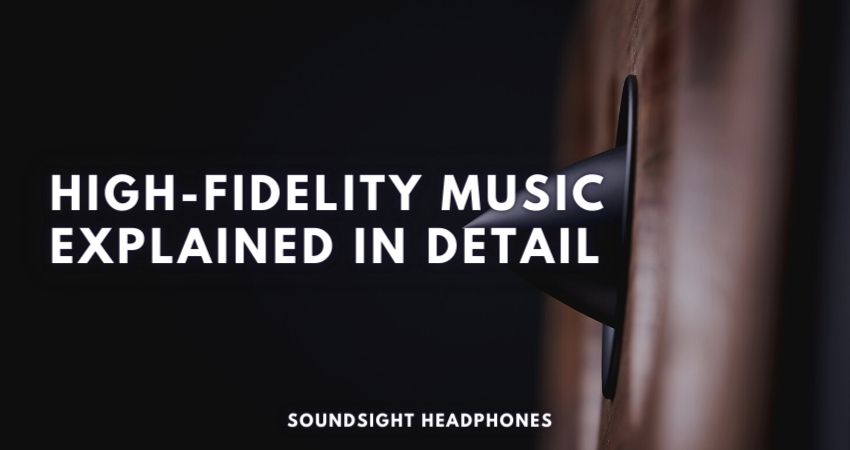
High-fidelity music explained in detail
In contrast to low-fidelity (or lo-fi music), there’s high fidelity, which hasn’t popularized as a genre as much as it has become an audio quality standard.
By definition, high fidelity implies a high-quality level of music, leading to an enjoyable experience listening to music. It’s the opposite of lo-fi, such as what you’d see in high-definition TV: a high sampling rate or high bitrate that gives the music superior sound quality.
High-fidelity music is superior to Low-Fidelity music in all forms, recording quality, audio digitization, mixing and mastering, and the sound itself. High-fidelity music results from the utmost attention to all facets of the recording: tens of hours of music composition, editing, professional mixing, and mastering.
As the saying goes, the devil is in the details, separating high-fidelity music from low-fidelity music.
But to be a bit more explicit, high-fidelity music entails the following:
- Natural, faithful, and clean recording of the sounds without deviating from the original musical performance.
- High-quality recording equipment used with the help of a professional sound engineer.
- High sampling rate and high bitrate audio quality. A high sampling rate is the number of samples per second recorded, and a higher sample rate offers a more accurate representation of the original sound.
- Increased complexity, coherence, and maturity of the audio.
- Complex rhythms and fine sampling of instruments, offering a clear and balanced sound.
- Balanced instrumentation, as well as well-developed arrangements.
- Use of multiple layers that are edited together to produce a rounded sound and full instrumentation.
- Full array of music notes (bass, mid, treble), with no clipping and minimal popping, artifacts, distortion, or background noise.
- Standard mixing techniques, high attention to detail, and quality control throughout the production cycle.
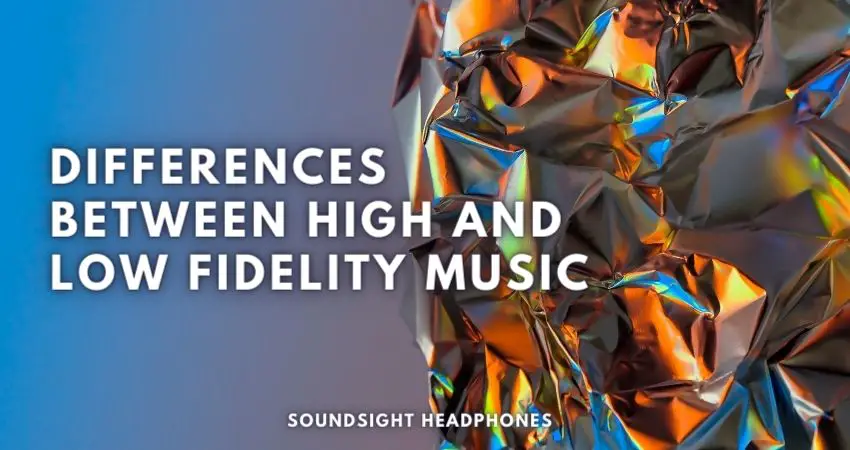
Differences between High and Low fidelity music
Now that you have a greater understanding of the distinct qualities that are associated with high and low-fidelity music styles, it’s time to compare their similarities and differences:
High fidelity music is superior to low fidelity music and offers a more complete listening experience
Hi-Fi music has less noise, distortion, and background noises than lo-fi music. Often you can’t tell the difference between Lo-Fi and Hi-Fi music when using poor-quality headphones or speakers. But when you play a properly recorded classic song on good-sounding audiophile headphones, you’ll instantly recognize the difference.
The high-fidelity recording played back on a high-fidelity headphone has a clearer, more balanced sound when listening to music. It also helps you listen to the subtle details in the music that would otherwise be missed when listening through a poor-quality set of headphones.
High-fidelity music is recorded and deployed as a lossless format (FLAC, WAV, or WMA) that is completely devoid of background noise or distortions. It also benefits from increased clarity in the mix’s broader sound spectrum with better depth and overall dynamic range.
Lo-Fi’s awesome convenience and accessibility
Lo-Fi music is the most convenient and accessible option for the modern audience. It’s available on every digital audio device, free of charge and in various formats.
Unlike high-fidelity music, low-fidelity music doesn’t require much storage space or professional audio devices. And due to its less demanding nature, it can be played easily on any smartphone, MP3 player, tablet, or wireless headphone and doesn’t require high-end equipment to pair with.
Lo-Fi style of music can be easily enjoyed with virtually any type of modern technology, which explains its popularity and proliferation on all platforms. It’s delivered in a variety of formats, such as MP3, AAC, or OGG, which doesn’t require much memory.
Low-fidelity music is free and available on several platforms, delivered in MP3 format and usually compressed at 192 Kbps.
You don’t need to hunt for high-fidelity music or buy it; just open YouTube and search for:
- “LoFi”
- “LoFi music”
- Or check out any songs from the LoFi Girl YouTube channel or Chill music.
Hi-Fi music is more thorough and requires more digital storage
When it comes to Hi-Fi music, digital audio needs more storage because Hi-Fi songs are recorded using a higher sampling rate. Because of this difference, you’ll need a music player with enough memory to store Hi-Fidelity music files, especially if they come in Hi-Res format, which can take up as much space as 9,216 kilobytes for each second of the song.
On the bright side, high-fidelity music is recorded at 16 or 24 bits, which means it contains enough audio bit information to produce a smooth, clean sound.
You can easily pick out each instrument with a clear distinction of highs, mids, and lows without losing the original sound of the recordings or distorting it. So when you compare high-fidelity music to low-fidelity music, you can hear them as clearly as day.
Simultaneously, it’s for this reason, Lo-Fi music is ideal for listening on portable devices such as smartphones with wireless headphones. In some cases, downloading Hi-Fi music is unnecessary as the high-res files are restricted by the small and low quality of the audio source or may hinder the limited memory of an Apple device.
Device dependencies – Lo-Fi vs. Hi-Fi
It’s evident now that you don’t need high-end audio devices or pricey headphones to listen to low-fidelity music. You get a better listening experience when using good-quality headphones, but that’s not necessary for listening to low-fidelity music.
On the other hand, if you want to truly enjoy the high fidelity music, you need to ensure you have good-quality components:
- A reliable amplifier
- High-end audiophile headphones
- FLAC audio files
- DAC/MP3 Player that is capable of decoding the files without any distortion.
It’s also important to note that if you want the best experience from Hi-Fi music, you will want to listen to adequately recorded music samples from a CD record.
Indeed, you won’t notice much difference in sound quality between 320 Kbps songs and FLAC (1,411 Kbps) songs, but high-fidelity music isn’t just about the number of bits of audio you store but rather about the quality of the recording; the carefully chosen arrangements, and refinement. LINK HERE

Examples of Hi-Fi and Lo-Fi music
The most popular types of LoFi music are Chill and Ambient music, which most people refer to when they talk about Low-fidelity music.
Lo-Fi music is technically an arrangement of beats and sounds that are usually in the form of instrumental and ambient music that is used for relaxation. It rarely features vocals and can also be described as a certain kind of indie music.
Lo-Fi music comes in numerous sub-genres: in the form of Hip-Hop, Chill, Post-Rock, Jazz, Downtempo, and many more. Its modern definition is the mix of Hip Hop and Electronic beats featuring an easy-listening mood and instrumentals.
Each sub-genre features a distinct set of instruments, signature sounds, and a unique style that clearly sets it apart from other sub-genre.
HiFi music is professionally produced music that caters to audiophiles and music lovers with a taste for complex music, grandiose music arrangements, and distinct exposition.
Examples of Hi-Fi music genres are:
- Classical music
- Jazz
- Blues
- Orchestral
- Soul
- Rock
Pretty much any music style with a tasteful arrangement, increased complexity, and various instruments is considered Hi-Fi music.
High-fidelity music is preferred by audiophiles because it doesn’t have much in common with Lo-Fi music. Hi-Fi music is for those interested in good sound quality, rich and high-resolution recordings with an overall high level of intricacy and depth; it’s a more advanced form of music that is recorded with higher quality and boasts better sound.
The following songs are considered to be part of Hi-Fi music:
- Hurt – Johnny Cash
- The White Buffalo – House of the Rising Sun
- Something about us – Daft Punk
- Queen – The Show Must Go On
- Anemone – Brian Jonestown Massacre
- Steely Dan – Do It Again
- Clair de lune – Claude Debussy (Piano)
The key difference between Hi-Fi and Lo-Fi music is in the complexity and production process, which dictates the overall sound quality you hear when listening to them.
FAQ about Lo-Fi and Hi-Fi music
What does LoFi mean?
LoFi is an abbreviation of Lo-Fi or Low-Fi, which means low-fidelity music, but not necessarily in a negative context. The terms Lo-Fi or LoFi arise with the popularity of simple, non-complex types of indie music with no lyrics or extravagant elements. Still, a few flaws were deliberately or indirectly left in the mix, giving it a raw and informal sound.
What makes LoFi music so popular and good?
The simple answer to this one is the popularity and quality of LoFi music has to do with the easy-going and mellow sound that people love so much.
Lo-Fi music is easy to listen to, doesn’t require too much of your attention, and can be enjoyed playing in the background. It doesn’t have specific parts that draw excessive attention, like the chorus, bridge, verse, etc.
Basically, Lo-Fi music is there to be enjoyed and to provide an easy-going and mellow listening experience, and nothing more. Its low simplicity and easy-to-digest character have made it an extremely popular genre of music that sounds good yet informal.
Is it possible to enjoy Hi-Fi music with regular headphones?
Not really. As stated earlier in the article, high-fidelity music has intricacies and musical features that need to be played accordingly to put into the limelight the best in the tracks. Without proper Hi-Fi headphones, the music lacks instrumental separation, sound clarity, fullness, and the spatial dimension that gives it an organic boost.
Is high-fidelity audio necessary for great music?
Yes, undoubtedly. If you have a good audio system or high-fidelity headphones, you need higher-quality audio files to enjoy music to the fullest.
High-fidelity headphones can bring out the best in Lo-Fi songs, but they really shine when paired with a lossless or Hi-Res FLAC audio file. This way, you’ll be able to hear each instrument clearly and fully enjoy your favorite tracks without missing a thing.
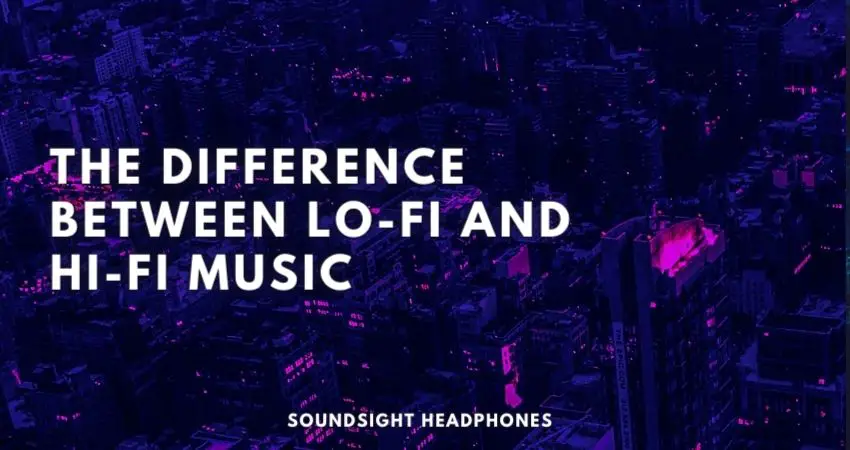
Lo-Fi vs. Hi-Fi Music – Conclusion
There are many differences and unique characteristics between Hi-Fi and Lo-Fi music. As always, the best approach to determine whether you’ll enjoy a certain type of music is to try it out.
So far, it has become clear that in the comparison between Lo-Fi and Hi-Fi music, Low-fidelity songs can be easily enjoyed from any device, while Hi-Fi music does have some necessities that must be met to fully enjoy it.
In the end, the ultimate difference between Hi-fi vs. Lo-fi boils down to the quality of music played back and the type of music that tingles your ears. If you greatly appreciate the endless types of sounds and instrumentals, then Hi-Fi should be your choice. In that case, check out this article about How to Buy Your First Hi-Fi Headphones. LINK HERE
Plenty of other topics revolving around Hi-Fi and Lo-Fi music will be covered in future articles. However, if you have any questions you’d like answered, feel free to drop a comment below.
